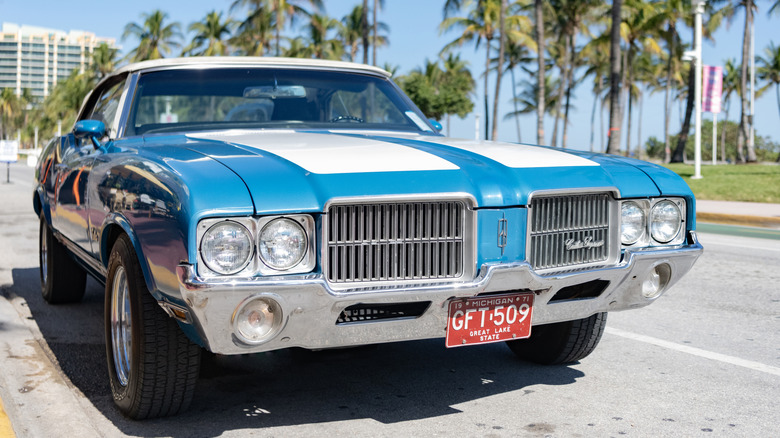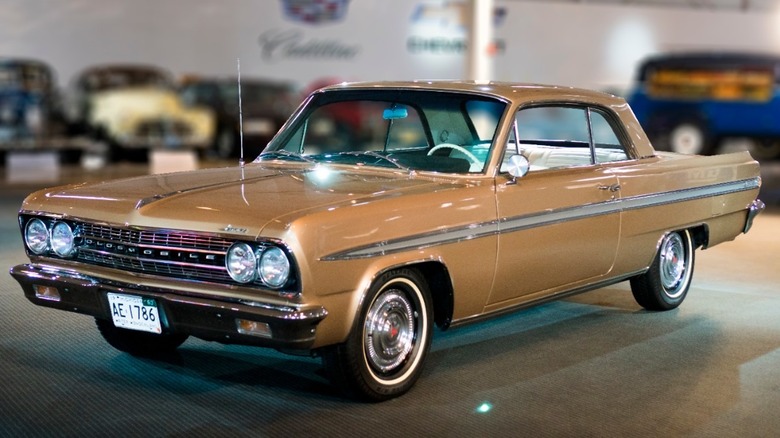
The Oldsmobile Cutlass and Oldsmobile Cutlass Supreme are both entries in the Oldsmobile F-85 series, a "senior compact" that came out in 1961. To understand their differences, we first have to go back to when the F-85 was released. It featured a Rockette V-8 engine borrowed from Buick that produced 185 horsepower. When it arrived on the scene, the F-85 was quickly overlooked by other models in the senior compact sector, so Oldsmobile had to push the F-85 a bit further.
In 1962, the Oldsmobile Cutlass
was introduced — a deluxe coupe version of the F-85. "Cutlass — even the name is exciting!" Oldsmobile boasted at the time. The Cutlass initially featured the same Rockette V-8, but offered an upgraded exterior and interior. There was a convertible option as well. Then, in 1963, four inches were added to the Cutlass to make it appear even larger. The Oldsmobile Cutlass 442 arrived in 1964, with a four-barrel carburetor, a 4-speed transmission, and dual exhaust that made it one of Oldsmobile's most beloved muscle cars.
The Cutlass Supreme was introduced in 1966, initially as another trim package for the F-85, this time offering a four-door hardtop variation. Two years later, GM realized that the F-85 was losing relevance as many people opted to purchase the Cutlass versions, mainly the Supreme, over the original.
Read more: 5 Cars GM Never Should Have Discontinued
The Success Of The Cutlass And Cutlass Supreme

In 1966, Oldsmobile started advertising the Cutlass as its own model rather than a trim of the F-85. The Cutlass — and all its variants — became Oldsmobile's most successful lineup. It continued to be the best-selling car in the United States throughout the 1970s, including its peak sales in 1977, topping out at 632,742 units sold. In comparison, the Toyota RAV4 has been the top-selling car in America for years, but it "only" sold 475,193 units in the U.S. in 2024.
During the Cutlass' reign in the 1970s, the 1973 Hurst package was the most popular. It crammed a 455 CID big block engine into the Cutlass S. The W46 was the desired package, adding a Turbo-Hydramatic 400 automatic transmission, a drag racing torque converter, and sway bars; however, buyers lost out on air conditioning.
By 1982, the larger, rear-wheel drive Cutlass Supreme became its own line, running with a standard V-6 or V-8 as its initial options. The Cutlass Supreme was also available with GM's diesel engine lineup, the only version of the Supreme that offered a 5-speed manual at that time. In 1988, production switched to front-wheel drive. It was also one of the early adopters of the heads-up display in some of its higher-end trims. The last year the Cutlass Supreme was produced was in 1997 — it had come a long way from the F-85's humble beginnings and is still coveted for its use as a quality vintage project car.
Other Spin-Offs Of The Oldsmobile F-85 Line

The Cutlass was not the end of the Oldsmobile F-85 variations — but it was the most successful. However, the Oldsmobile F-85 also introduced the Jetfire in 1962, one of the first production vehicles to have turbochargers. Despite the innovation, the Jetfire was short-lived, and only sold 9,607 units between 1962 and its last production year of 1963.
At first, the turbocharger seemed like a game-changer. Bolted onto the engine, the T5 turbocharger gave the Jetfire 215 horsepower and added 30% more torque. As a result, the Jetfire could hit 60 miles per hour just about twice as fast as the Cutlass. Unfortunately, turbos were a new technology at the time that carmakers and drivers were not prepared for. The suspension could barely handle the increased acceleration, and owners kept forgetting to refill the "rocket fluid" tank that required a blend of methyl alcohol and water to keep the engine running as intended. The Jetfire's engine proved to be too far ahead of its time. However, despite this flop, Oldsmobile remained at the top of its game with the other F-85 spin-offs such as the Cutlass.
Want the latest in tech and auto trends? Subscribe to our free newsletter for the latest headlines, expert guides, and how-to tips, one email at a time.
Read the original article on SlashGear.












